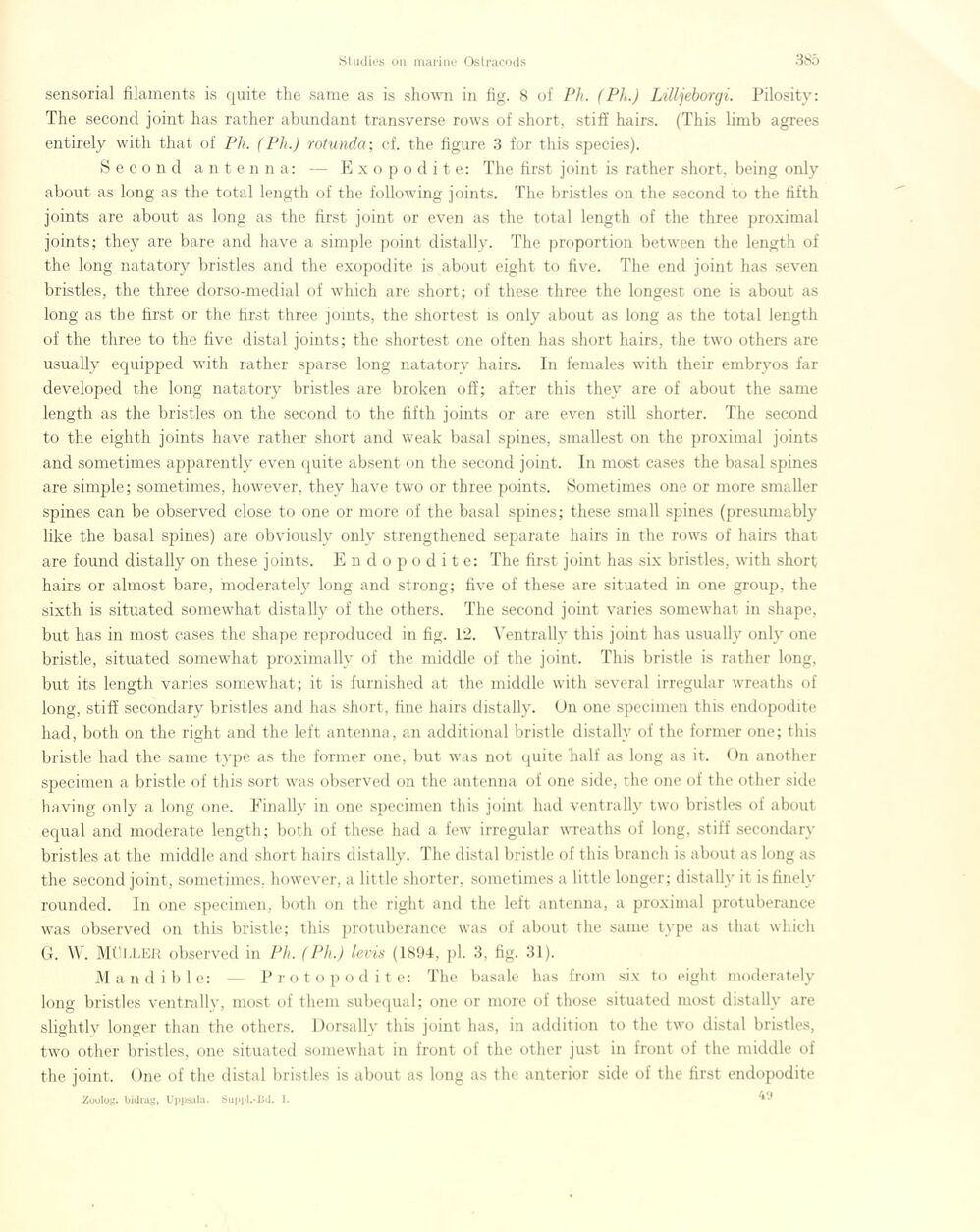
Full resolution (JPEG) - On this page / på denna sida - Sidor ...

<< prev. page << föreg. sida << >> nästa sida >> next page >>
Below is the raw OCR text
from the above scanned image.
Do you see an error? Proofread the page now!
Här nedan syns maskintolkade texten från faksimilbilden ovan.
Ser du något fel? Korrekturläs sidan nu!
This page has never been proofread. / Denna sida har aldrig korrekturlästs.
sensorial filaments is quite the same as is shown in fig. 8 of Ph. (Pli.) Lilljeborgi. Pilosity:
The second joint has rather abundant transverse rows of short, stiff hairs. (This limb agrees
entirely with that of Ph. (Ph.) rotunder, cf. the figure 3 for this species).
Second antenna: — Ex op odite: The first joint is rather short, being only
about as long as the total length of the following joints. The bristles on the second to the fifth
joints are about as long as the first joint or even as the total length of the three proximal
joints; they are bare and have a simple point distally. The proportion between the length of
the long natatory bristles and the exopodite is about eight to five. The end joint has seven
bristles, the three dorso-médial of which are short; of these three the longest one is about as
long as the first or the first three joints, the shortest is only about as long as the total length
of the three to the five distal joints; the shortest one often has short hairs, the two others are
usually equipped with rather sparse long natatory hairs. In females with their embryos far
developed the long natatory bristles are broken off; after this they are of about the same
length as the bristles on the second to the fifth joints or are even still shorter. The second
to the eighth joints have rather short and weak basal spines, smallest on the proximal joints
and sometimes apparently even quite absent on the second joint. In most cases the basal spines
are simple; sometimes, however, they have two or three points. Sometimes one or more smaller
spines can be observed close to one or more of the basal spines; these small spines (presumably
like the basal spines) are obviously only strengthened separate hairs in the rows of hairs that
are found distally on these joints. Endopodite: The first joint has six bristles, with short
hairs or almost bare, moderately long and strong; five of these are situated in one group, the
sixth is situated somewhat distally of the others. The second joint varies somewhat in shape,
but has in most cases the shape reproduced in fig. 12. Ventrally this joint has usually only one
bristle, situated somewhat proximally of the middle of the joint. This bristle is rather long,
but its length varies somewhat; it is furnished at the middle with several irregulär wreaths of
long, stiff secondary bristles and lias short, fine hairs distally. Un one specimen this endopodite
had, both on the right and the left antenna, an additional bristle distally of the former one; this
bristle had the same type as the former one, but was not quite half as long as it. On another
specimen a bristle of this sort was observed on the antenna of one side, the one of the other side
having only a long one. Finally in one specimen this joint had ventrally two bristles of about
equal and moderate length; both of these had a few irregulär wreaths of long, stiff secondary
bristles at the middle and short hairs distally. The distal bristle of this brandi is about as long as
the second joint, sometimes, however, a little shorter, sometimes a little longer; distally it isfinely
rounded. In one specimen, both on the right and the left antenna, a proximal protubérance
was observed on this bristle; this protubérance was of about the same type as that which
G. W. Müller observed in Ph. (Ph.) levis (1894, pl. 3, fig. 31).
Mand ib le: — Protopodite: The basale has from six to eight moderately
long bristles ventrally, most of tliem subequal; one or more of those situated most distally are
slightly longer than the others. Dorsally this joint has, in addition to the two distal bristles,
two other bristles, one situated somewhat in front of the other just in front of the middle of
the joint. One of the distal bristles is about as long as the anterior side of the first endopodite
Zoulog. bidrag, Uppsala. Suppl.-Bd. I. ^
<< prev. page << föreg. sida << >> nästa sida >> next page >>